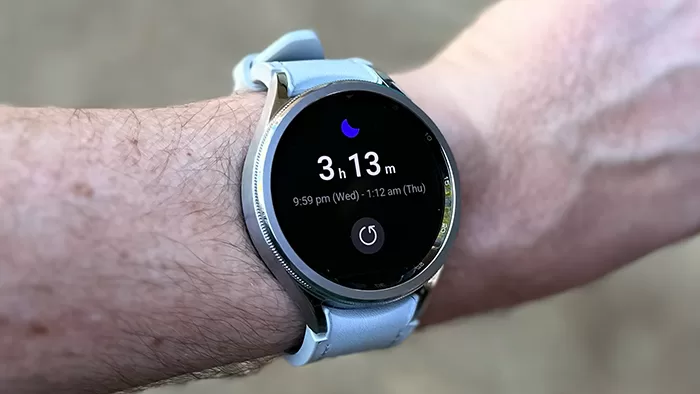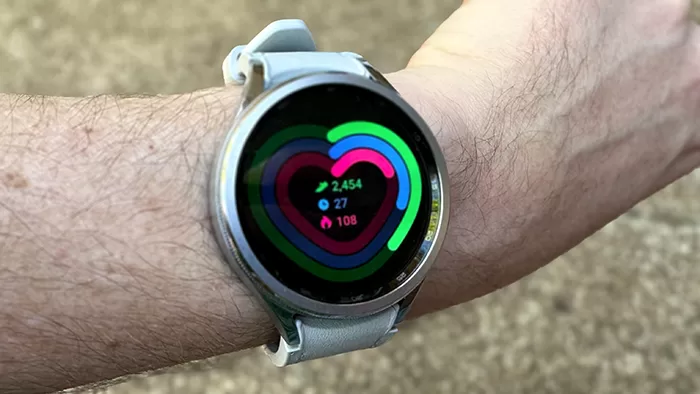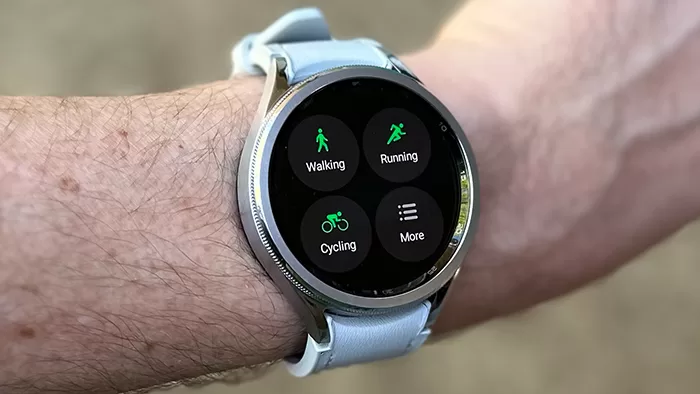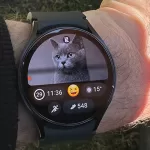
Its rotating bezel does lift the Galaxy Watch6 Classic above its smaller sibling, but smartwatches remain a luxury buy — especially at its asking price.
| Pros | Cons |
|---|---|
| Rotating dial is still excellent | Costs more than regular Galaxy Watch6 |
| Works well within the Samsung ecosystem | Big watch faces won’t suit everyone |
| Good selection of tracking features | Slightly uncomfortable for sleep tracking |
Score: 3.5/5
 |
Buy The Samsung Galaxy Watch6 Classic! | Buy On Amazon |
I’ve made no secret over the years that I considered Samsung’s best play in the smart wearables space to be the rotating bezel that came as as a standard part of many of its early “Gear” smartwatches.
It’s been frustrating then over the past couple of years, because Samsung seemingly taunts the fans of the rotating bezel, offering it on one generation of smart wearables, and then not again on the next.
2023, it seems, is a rotating-bezel friendly year, so alongside the more basic (and more affordable Samsung Galaxy Watch6 that I’ve already reviewed, there’s the more premium Galaxy Watch6 Classic.
Also Read:
Samsung Galaxy Watch6 Review
But in 2023, does the return of the rotating bezel mean that it’s still a classic?
Design

Having already reviewed the Galaxy Watch6, coming to the Galaxy Watch6 Classic felt very familiar indeed – just bigger.
That’s because the Galaxy Watch6 Classic ships in larger sizes than the regular Watch6; where it runs to 40mm or 44mm watchfaces, the Galaxy Watch6 Classic comes in either 43mm or 47mm sizes. Samsung loaned me the larger 47mm model for review, and it’s certainly a striking looking watch.
The 47mm Galaxy Watch6 Classic is built around a 1.5 inch circular Super AMOLED display with a claimed 480×480 resolution, though naturally enough you’re going to lose a few of those pixels around the circular sides of the display.
Unlike the Galaxy Watch6, you’re not limited in colour choices when you’re choosing the size of the watch you want, with either silver or black finishes available; my review model was the silver, though aesthetically I feel the black might have the edge here. That’s 100% a taste matter, naturally.
The big difference between the Galaxy Watch6 Classic and its more minute siblings is naturally enough in the inclusion of the rotating dial that I have loved so very much on prior generations when Samsung’s remembered to offer it.
Spoiler: I still do.
It’s not just about the dial though, with buttons on the right hand side that can be customised, as well as the use of touch to swipe and select onscreen items. All of this works well… but then that was true for the Galaxy Watch6 too.
Performance

As with its smaller sibling, how you set up the Galaxy Watch 6 will depend on the smartphone you intend to pair it with.
Apple iPhone users are not welcome in any way, but that’s been the story for the past few generations of Samsung wearables, and across quite a few other Android brand watches too. It seems the battle lines are rather distinctly drawn here.
Samsung would prefer you played in its walled garden instead, which is why if you’re using a Samsung smartphone and it detects the Galaxy Watch6 Classic powering up, you’ll get a simple pop-up window to start the pairing process. That’s what I did in the first instance, pairing the Galaxy Watch6 Classic with a Samsung Galaxy Z Flip5.
Also read:
Samsung Galaxy Z Flip5 Review
Other Android phones will pair as long as they’re running at least Android 10 with 1.5GB RAM or better, but you’ll have to grab Samsung’s wearable apps to manage the pairing process on the way.
Like the Galaxy Watch6, the Galaxy Watch6 Classic runs on Google’s WearOS 4 with Samsung’s One UI 5 launcher layered on top of it. It’s relying on Samsung’s new Exynos W930 processor, which I found to be nicely responsive when I tested it out on the Watch6 as well. It is worth knowing that the differences between both essentially boil down to screen size and the rotating bezel, because under the hood they’re packing the same underlying systems.
Which brings me back to the rotating bezel, and the way that it works with WearOS 4.
There is a learning curve here, both in remembering that you can use the bezel, and in getting the spin speed right relative to the contextual menu or screen you might happen to be in.
It’s never a mandatory part of the UI – which could be good news if you happened to break or jam the bezel – but it very quickly became my “natural” way to interact with the watch, because it’s fast and there’s just something to having a physical control like this that’s not only fun but also nicely efficient. I liked the Galaxy Watch6, but there’s no doubt that I enjoyed my time with the Galaxy Watch6 Classic more… mostly.

Like the Galaxy Watch6, the Galaxy Watch6 Classic offers up Samsung’s suite of health, sleep and fitness tracking applications specific to its hardware. I had few complaints about its fitness tracking once it got its GPS lock in place, though the faux leather band isn’t ideal for sweaty jogging purposes.
Where I found it just a little more problematic was in sleep tracking. Not that it
wasn’t accurate (as far as I’m able to judge), but simply because in being a much larger watch, I found it harder to sleep with the Galaxy Watch6 Classic on my wrist.
More than once it registered me being awake in the middle of the night, and I was, because I’d rolled over and thumped the watch against a pillow uncomfortably, or in one instance on my face.
Yes, I’m a messy and complicated sleeper, but the point here is that a bigger watch is a harder watch to fall asleep with. Or at least it is for me.

One area where WearOS absolutely dominates the smart wearable space in my view is in letting you set the watch face as you personally want it to look. Apple’s produced some nice watch faces, but you’re 100% at the mercy of its designers and what they want, where the marketplace for WearOS watch faces is totally open. That matters a lot more, I think, when you’re talking about a circular watch that actively looks like an old school mechanical watch.
If you want an analog face that mimics a high end timepiece, they’re out there, albeit with a few copyrighted logos smudged out. Want a more digital look with lots of data on the primary screen? That is also possible.
If you’re keen on standalone data, you can pay extra for an LTE variant of the Galaxy Watch6 Classic, but the model loaned to me was just the basic Bluetooth variant. You’d also need to ensure that your telco of choice supported that kind of eSIM operation; the big telcos generally do, but if you’re with an MVNO it’s a lot less assured.
Battery

The Galaxy Watch6 Classic’s larger size does allow Samsung to throw a fair amount of battery capacity behind its glass screen – at least, by wearables standards anyway. Where the regular Galaxy Watch6 and 43mm Galaxy Watch6 Classic have 300mAh batteries, the big lad watch gets 425mAh of battery capacity to play with.
There’s no real way to “benchmark” a smartwatch, because usage is 100% anecdotal and matters like screen brightness and heavy use of Bluetooth – and especially LTE, not that I could test that – can have dramatic effects on overall battery life. So all I can go off is more anecdotal data based on my own limited testing time.
That suggests that the Galaxy Watch6 Classic can last longer than the smaller Galaxy Watch6, which typically made it through a single day’s testing, but not much more.
I typically found the Galaxy Watch6 Classic good for a day and a half, and I’m willing to believe that for some users that might just stretch into the evening of the second day if your smartwatch was more ornament than wrist-bound computer.
Mind you, if that’s true, I’d still suggest you’d be better off with a regular wristwatch anyway. They do still exist, you know.
Recharging is via a wireless custom puck on a cable, but as with many smartwatches – and a lot of smartphones – there’s no included charger in the box.
Samsung Galaxy Watch6 Classic: Alex’s Verdict

I made no secret of the fact that I’m a fan of the rotating bezel at the start of this review for a reason.
Being in favour of a device feature creates a rather natural bias, so it shouldn’t be a shock that if I had the choice, I’d take the Galaxy Watch6 Classic over the Galaxy Watch6 every single time.
Just because I like the rotating bezel does not automatically mean that it’s the ideal option for you, however.
I can’t ignore the fact that the Galaxy Watch6 Classic is more expensive than the regular Galaxy Watch6 basically just for that bezel and a slightly larger screen size. The bigger size did make it less comfortable when sleeping, too.
It’s best suited, I think, for classic watch fans who also have Samsung devices to pair them with. In the wider Android ecosystem if you’re after a smart wearable it’s definitely a solid choice, but one with other competitive models to consider if you’re in the buying mood.
Samsung Galaxy Watch6 Classic: Pricing and availability
The Galaxy Watch 6 Classic retails in Australia for $699 with a 43mm face and Bluetooth/Wifi, or $799 with 4G.
The 47mm Galaxy Watch6 Classic as tested will cost you $749, or $849 if you want the LTE/4G model.
 |
Buy The Samsung Galaxy Watch6 Classic! | Buy On Amazon |









